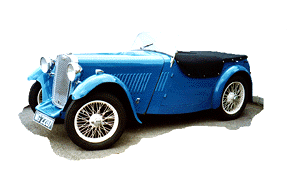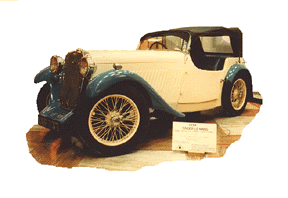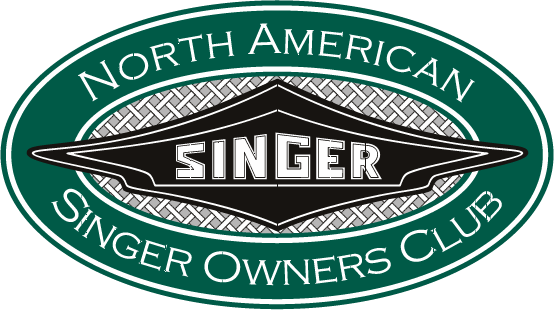9 Sports
Encouraged by the success of the earlier “Nine” two seater sports cars, Singer introduced the new Nine Sports in the fall of 1932. Although it represented an evolution of the Junior and the 9 h.p. range of cars, it was quite a distinctly different machine, even being built in a different factory. The Nine Sports was manufactured in Coventry, whereas the other models were built at the Birmingham site.
The Nine Sports was modeled after the Le Mans styling of the day. While it was certainly a four seater, a third or forth passenger could be carried, at least short distances, sitting in a rather upright fashion in what was a fairly cramped rear seating compartment. Leg room in the rear was accommodated by two deep wells on either side of the propeller shaft.
Leg room in the rear was accommodated by two deep wells on either side of the propeller shaft.
The Nine Sports was fitted with the familiar 972 cc. overhead cam engine, which now had an increased bore of 60mm fed by twin downdraft S.U. carburetors. The gear box had a very close ratio which made it especially suited to trials work where maximum speed was not as important as power and acceleration. Half elliptic springs were used all around and they were controlled by large adjustable André Hartford friction shock absorbers. The suspension was unusually good, providing suppleness with a complete absence of any sign of wheel shimmy, rolling or pitching. Lockheed 10 inch hydraulic brakes were standard on both front and rear and allowed for fairly powerful braking. The Nine developed approximately 31 b.h.p. at 4600 R.P.M and could reach a speed of over 66 m.p.h. with the windscreen lowered flat. With the windscreen raised, top speed was slightly lower at approximately 64 m.p.h. An easy cruising speed of 50 m.p.h. could be maintained.
The Nine Sports marked the first really serious onslaught on the patronage of sports car enthusiasts. Immediately, it was hailed as “looking right” and within a very short time it had proven itself to be a winner on the score of performance. Early examples romped around the late autumn trials and a fleet of nine of them scored heavily, taking 8 premier awards in the London to Exeter run at Christmas.
The Nine won high praise when an essentially stock model driven in the 1933 Le Mans by Barnes and Langley became the first unsupercharged British car under 1000 cc’s to qualify for the Rudge-Whitworth Biennial Cup. Modifications to the car from stock included a mildly tuned, higher compression engine, altered gear ratios, larger headlights and a long range gas tank which entirely displaced the rear seating compartment.
Singer continued to prove the Nine’s mettle in other grueling long distance reliability competitions. Notably, a team of three Nine Sports production models were entered in the Alpine 6 Day’s Trial, held over some of the highest mountain passes in Europe. The entire Singer team finished intact to win a second place finish for cars under 1100 cc’s.
Equipped with an impressive array of instruments, an Ashby Brooklands steering wheel, a mahogany dashboard and trimmed in furniture hide upholstery, the Singer was a bargain. Priced at only 185 pounds, the stock Nine Sports matched and beat its closest rivals in quality, performance and price.
From 1933 to 1937, the Nine Sports was steadily and continuously improved and updated in both subtle and obvious ways. For 1934, one of the most  evident changes was the modification of the front fenders. The original 1933 models had a very abbreviated fender which provided inadequate protection from gravel and dirt kicked up by the front tires. To protect the paint on the side of the car, longer, more graceful front fenders, with small gutters concealed on the underside of the rear tip were introduced.
evident changes was the modification of the front fenders. The original 1933 models had a very abbreviated fender which provided inadequate protection from gravel and dirt kicked up by the front tires. To protect the paint on the side of the car, longer, more graceful front fenders, with small gutters concealed on the underside of the rear tip were introduced.
Substantial changes were also made to the 1935 model, which saw the addition of running boards, wider doors and a graceful sweeping tail into which the spare was stowed, concealed by a detachable cover. A light, removable luggage grid was also provided and fitted to the rear of the car.
9 Sports Specs
Engine
Four cylinder, 60 mm. by 86 mm. = 972 c.c.
Treasury rating, 8.93 h.p.; tax 9 pounds
Valves operated by chain driven overhead camshaft
Alloy pistons
Coil ignition with automatic spark advance
Twin downdraft carburators
Fan assisted cooling
Vibro damping engine mountings
Gearbox and Transmission
Four speeds with ratios 5.57, 8.7, 12.4 and 24.4 to 1and 33.6:1 reverse
Silent second and third gears
Remote control shift lever
Flexible centre clutch
Open propeller shaft with Hardy Spicer mechanical universal joints
Spiral bevel rear axle
Wheels and Brakes
18 inch Rudge-Whitworth knock on wheels
4.50 X 18 inch tires
Four wheel Lockheed hydraulic brakes, 10 inch drums
General
12 volt lighting and starting system
Wheelbase 7 ft. 8 ins. with 8 inch ground clearance
Price
185 pounds
